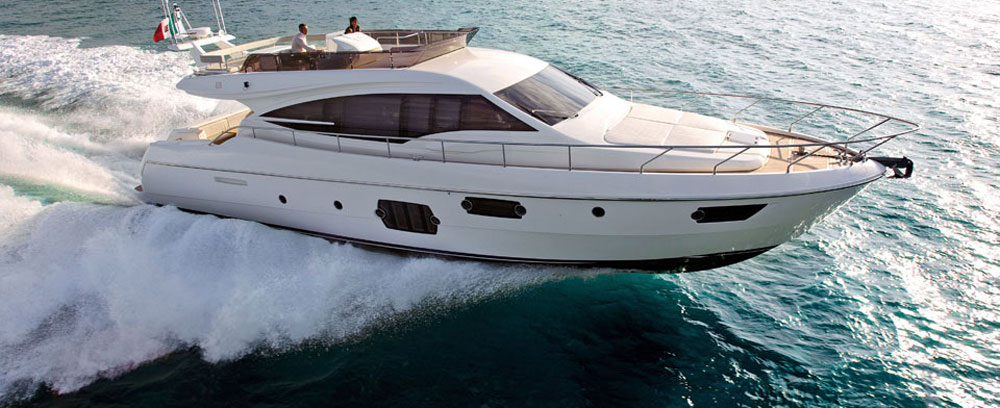
Ferretti 620 11111
Let me admit this right up front. I was prepared to “like” the new Ferretti 620, but I was fairly sure that I wasn’t going to love her to death.
She is, after all, the latest confection from this Italian builder on this side of the Atlantic, and she’s full of stitched leather and whitewashed oak and the many amenities you’d expect in an Italian palazzo overlooking the sea (see the complete photo gallery here).
It would be easy for me, calloused yacht tester that I am, to dismiss the 620 as just another Portofino Palace, a stylish transporter of crumpets and champagne along the Riviera. She seems like a yacht designed for lazy afternoons in the sun, a few getaway weekends moored stern to the quay in St. Tropez, and perhaps an annual outing to Corsica or Sardinia. She doesn’t seem a yacht for the “serious American yachtsman.”
And then I had The Epiphany.
She is esattamente the kind of yacht our serious yachtsmen will appreciate because, you see, this is how we use our boats too. Language differences apart, Italian yachtistas are just like American skippers. We don’t set off on voyages to tropic isles and we don’t plan to live aboard. We, and they, have limited time in our busy schedules, which means that a weekend aboard is a vacation, and a Sunday boat ride and barbecue are what anesthetize us for the workweek ahead.
They may go to places like Monte Carlo or Porto Venere, but we have Block Island or Catalina or the San Juans or the Keys. Sometimes we get a week or two to spend aboard, and so do they. There is an international bond among yachting enthusiasts who, if they are honest, will admit they never have enough time to enjoy their boats.
And the Ferretti 620 is perfect for all of us, Italian or American.
More than a little of this perfection is the result of the Italian builders listening to experienced American advisors like Brian Kelley, the North American Ferretti product manager.
The basic 620 is a very nice yacht, but Kelley quickly realized that it needed some massaging to fit American needs and tastes. First to go was the stern passerelle, which is rarely needed here in the New World, and which eliminated some complexity and added space. Next to go was the enclosure around the galley that, again, is de rigueur in Europe, where the cook’s presence should be tasted but never seen. In America, the chef is part of the family and isn’t to be locked away.
This tinkering has created a yacht that is a delight on many levels. She is a powerful performer that is exceedingly comfy for two couples and kids on a weekend, and she’s a yacht that begs to invite your best friends aboard for a barbecue.
Which is not to say that there are not a few, um, Italianate quirks, but none that are either so irritating or so incurable that you wouldn’t buy this yacht. More later.
At first glance, there’s no question that the 620 is Italian, with curvaceous lines, a sheer that romps rather than swoops and a rakish look from reversed transom to swept-back spoiler. Of course, so many North American builders either use Italian designers or steal their ideas that the 620 might well be built in Nebraska. But, no, this is authentic Italiano, from the dual-language electrical panels to the Euro appliances in the galley.
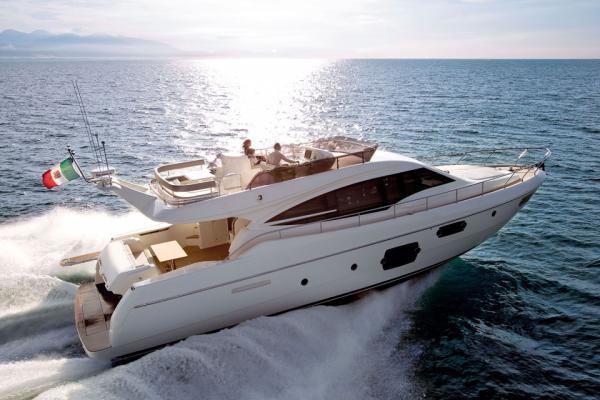
Neither of these, I must add, are the problems I mentioned earlier. The panel labeling is clear, and appliances, such as Miele, Bosch and Isotherm, are now as easily repaired stateside as are GE or Whirlpool.
With the bulkhead removed from around the galley, your first impression when you step into the salon is of an unbroken, airy expanse. The absence of bulkheads between the cockpit and the wraparound windshield makes the salon seem immense. With the galley and a buffet/bar aft on one level and the entertainment area and helm raised slightly, it fulfills Norberto Ferretti’s goal to “bring the outdoors into the yacht.”
When the window by the galley is hinged up and the sliding doors are moved aside, even the shaded cockpit is included in this sweep of salon. One particularly impressive feature is the one-piece curved windshield unmarred by the usual support mullions, and if you don’t think glass bends, consider that it was perfectly flat before being sealed into place.
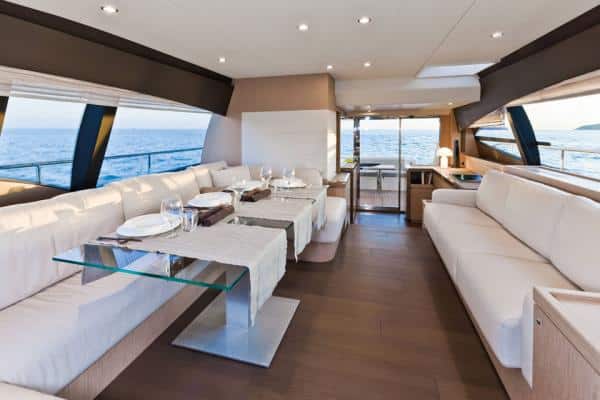
The midsection of the salon has a leather couch facing an oversize wraparound settee. The glass table expands for dining or contracts to turn the area into a lounge to enjoy the pop-up TV to port.
On our test boat, salon décor was a mix of white leather upholstery, pale ash woodwork, gray stitched leather paneling and chocolate fiberglass sections. Neutral and very appealing, it underlined that this is an adult yacht and not one for kids armed with Crayons.
The galley is sleek and stylish, with a composite counter and good backsplashes, although missing any fiddles on the front edges. Included in the appliances are a Bosch four-burner cooktop, microwave, dishwasher and Isotherm refrigerator hidden behind ash paneling. Two of the counters separating the galley, as well as the counters on the facing buffet/bar, were inlaid with stitched white leather to match the seating. In my world, that would mean we were drinking only white wine, because I would slit my wrists if I discovered a circular vino rosso stain on that sumptuous Italian leather. (On second thought, I wouldn’t: Blood also stains!)
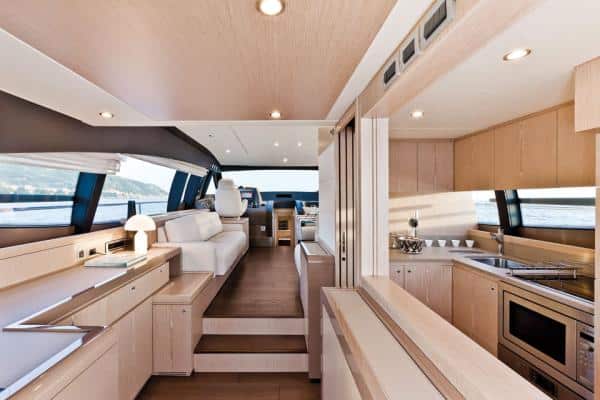
Galley stowage is of the “let’s eat out” size, and, while a large wine locker is under the helm seat forward and there is dedicated space for Ferretti glassware in the buffet, Americans may find it challenging to stash a box of Wheaties — lots of smallish nooks, no pantry. I’m told this is being addressed, so bring on the breakfast cereals.
The helm is clearly designed for a slim Italian, and most Americans will probably want the helm seat moved aft a bit so they don’t become a permanent fixture wedged between seat and wheel. Tucked under the seat console is a wine cooler (remember, white only!), and the entire dash assembly has a lovely faux suede finish.
Outboard of the helm seat is the electrical panel, and I liked the Lucite cover over the lower horizontal section to protect against spills. Our test 620 was fitted with a Furuno NavNet 3D monitor and three digital MAN engine screens, with space for more. I love the compact ZF shifters for their precision, and perhaps because they remind me of the equally precise controllers for my childhood model trains. I also give Ferretti credit for a monitoring panel that shows the yacht in profile, with tiny lights indicating any systems in use. It’s a multilingual warning of bilge pumps that are running or running lights that are not.
The master suite is everything you could want in a cool and serene getaway — with one caveat. Located below the salon, the master spans the full beam, giving anyone in the forward-facing queen-size berth the full benefit of views through large windows (with two opening ports) on each hull side. A built-in bureau is to port, a settee to starboard, and there is a large walk-in closet off the entry from the foyer. Just as thoughtful is the hidden full-size washer and dryer in the foyer.
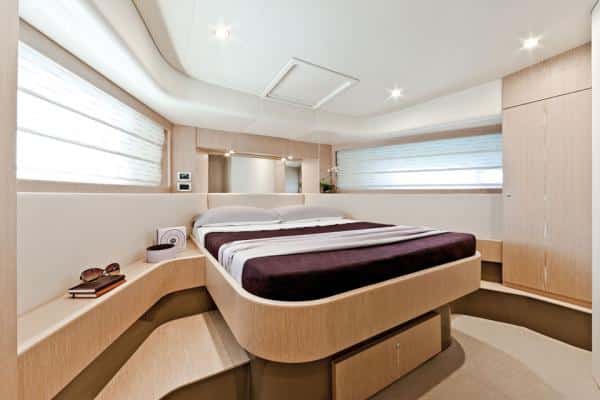
OK, now we come to a quirk. The master head also spans the full beam just abaft the suite, with a Tecma MSD and vessel sink all the way to starboard, and a large shower with seat all the way to port. This leaves a rather useless walkway between the two. With a second door to the head on the port side and a centerline shower, this could be a terrific his-and-hers head without dead space. When I left, Kelley was noodling out how to do it.
Forward, the larger guest cabin continues the “bring the outdoors in” theme with big windows on each side of the queen-size island berth. The cabin is simple but elegant, with one large drawer under the berth and two hanging lockers, and it has a comfortably large en suite head with a shower that Americans will appreciate.
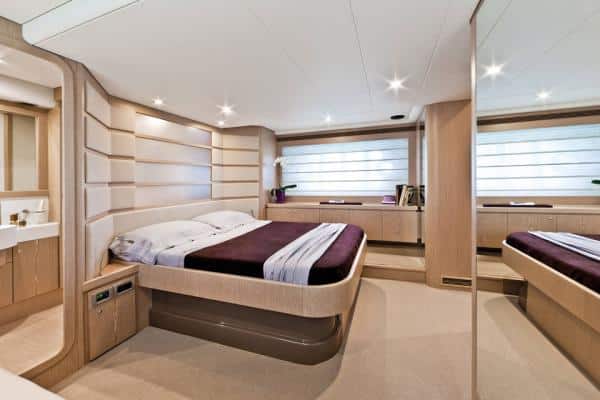
Finishing up the accommodations is the children’s cabin on the starboard side, with two singles and a private door into the day-head, which has a two-part rotating door that creates a shower “tube” when needed.
Then, of course, there is the crew cabin. Instead of the usual impossible European ladder into a dungeon, this has a nearly impossible stairwell from the corner of the cockpit that leads to a quite civilized (but tiny) cabin with single berth, head and shower. For owners on this side of the pond, it’s a good place for a teenager. Or that slim Italian who can get down those narrow stairs.
The bridge, however, has very comfortable stairs from the cockpit, making access safe and secure. Once there, the helm is tucked to starboard with a double-wide bench seat, and the instruments are in a fold-up pod that closes for weather protection. Opposite is another double-wide, and the entire forward area to the venturi windscreen is a huge sun pad.
Behind the companion seat is a wet bar with space for a barbecue, and a wraparound couch and fiberglass table that fills the after end of the bridge. One item of concern that I’ve mentioned several times is the radar mounted on the low spoiler just behind the couch. This is right at head level and well inside the 13-foot safety zone recommended by Furuno for radar emissions. As I wrote before, you can turn the radar off when anyone is on the bridge, but that’s where you’ll want to be in case of fog. On the other hand, you may be able to put a raw steak on the flybridge table and cook it to your preference by changing the range on the radar. I don’t know, but it seems worrisome.
Power for our test 620 was a whacking great pair of 1,100-horsepower MAN diesels, offered as an option instead of the standard 900-horsepower MANs normally ordered for the American market. The bigger diesels are V-10s, and they seem to be very quiet, with less vibration than V-8s.
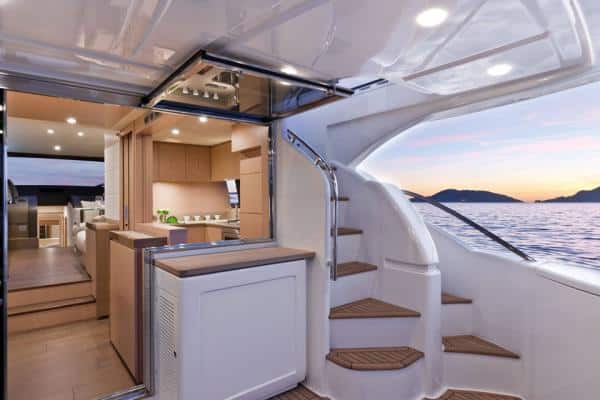
The engine room is a delight, with nearly full headroom, rubber nonslip on the walk-around areas and full gelcoat in the bilge. Access to the engines is excellent, with dipsticks mounted facing inboard, oil and water filters close at hand, and a protected sight gauge for the fiberglass fuel tank, which separates the engine room from the crew quarters. The standard genset is a 21.5 kW Onan, which is a change from the usual Kohler found on Ferrettis, and it makes a compact and quiet package in its sound shield.
We didn’t have any seas to challenge our test, but since the 620 hull is an extended version of the successful Ferretti 592, I have no qualms that it is soft-riding and dry. And, to put it succinctly, it hauls. We topped out at more than 32 knots, plenty rapid for a 62-footer weighing in the neighborhood of 37 tons, which I take to be a testament to her slippery hull lines. At an easy cruise of 2000 rpm, we were still knocking off over 25 knots and the engines weren’t breathing hard.
We may not be carrying a cargo of Dom Perignon to Monte Carlo, but Americans will nonetheless find a great deal to love about the Ferretti 620. She is absolutely perfect for how most of us use our yachts, and she is solidly built, thoughtfully equipped and thoroughly luxurious. Don’t miss this Italian beauty.
LOA: 61’7″
LWL: 52’6″
BEAM: 17’3″
DRAFT: 4’11”
DISPL.: 82,673 lb.
FUEL: 978 gal.
WATER: 140 gal.
ENGINE OPTIONS: 2 x 900 hp MAN diesels
ENGINES TESTED: 2 x 1,100 hp MAN diesels
BASE PRICE: Upon request
Test conditions: Speeds were measured by GPS off Fort Lauderdale, Florida, with calm seas and 5-knot winds, with ½ load of fuel, ½ load of water and five people on board. Fuel consumption was calculated by the electronic engine-monitoring system. Sound levels were measured at the lower helm.
RPM Knots GPH dB(A)
600 6.8 8.9 62
900 10.8 17.2 62
1200 12.9 22 62
1500 15.9 45 62
1800 21.8 64 64
2100 28.3 89 68
2350 32.2 116 70
Ferretti Group of America, 954-462-5527; www.ferretti-yachts.com









